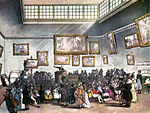
A Dutch auction is one of several similar types of auctions for buying or selling goods.[1][2][3] Most commonly, it means an auction in which the auctioneer begins with a high asking price in the case of selling, and lowers it until some participant accepts the price, or it reaches a predetermined reserve price. This type of price auction is most commonly used for goods that are required to be sold quickly such as flowers, fresh produce, or tobacco.[4] A Dutch auction has also been called a clock auction or open-outcry descending-price auction.[5] This type of auction shows the advantage of speed since a sale never requires more than one bid. It is strategically similar to a first-price sealed-bid auction.[6][7]
- ^ "Sourcing Innovation | Supply Chain Glossary | Reverse Auction". www.sourcinginnovation.com.
- ^ "Dutch Auction". saylordotorg.github.io.
- ^ "Dutch Auction - Understand How A Dutch Auction IPO Works". Corporate Finance Institute.
- ^ Mishra, Debasis; Parkes, David C. (May 2009). "Multi-item Vickrey–Dutch auctions". Games and Economic Behavior. 66 (1): 326–347. doi:10.1016/j.geb.2008.04.007. S2CID 913475.
- ^ Sarna, David E. Y.; Malik, Andrew (2010). History of greed : financial fraud from tulip mania to Bernie Madoff. Wiley. ISBN 978-0-470-60180-8.
- ^ "Dutch Auction and First-Price Sealed-Bid Auction". www.econport.org.
- ^ "Dutch auction". pi.math.cornell.edu.
